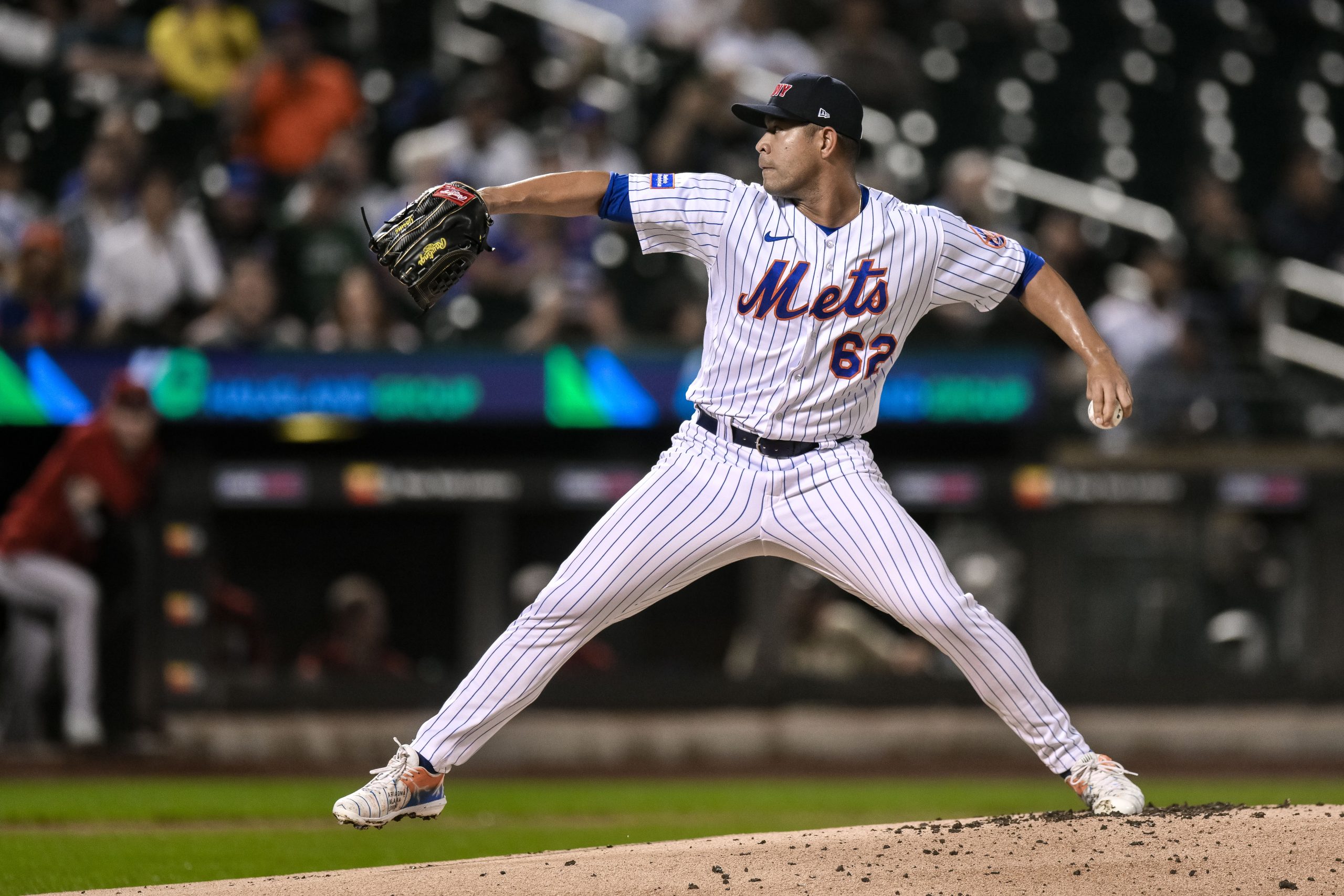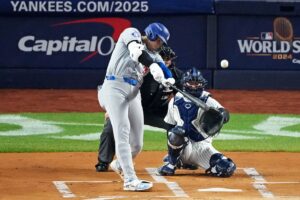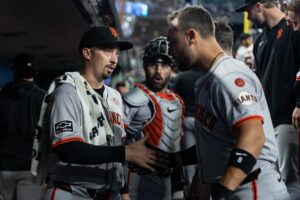After a busy trade deadline, the New York Mets currently have only two starting pitchers locked into rotation spots next year. Depth behind José Quintana and Kodai Senga include a trio of unestabslihed mid-20-year olds and a plethora of prospects that might be ready at some point in 2024. Despite the dire need for starters, trading Quintana makes sense for the Mets this offseason.
Many anticipate New York to be active this winter and push for a playoff spot next season. The team currently stands as the favorites to sign Japanese ace Yoshinobu Yamamoto to deal that could be worth around $200 million. It’s also expected that the team brings in one or two additional starters to round out the rotation.
The Mets were among the most active teams in each of the last two winters, highlighted by record deals for two almost-40-year-olds. While few think owner Steve Cohen will be reluctant to remain aggressive in improving the team, reports indicate that Cohen learned his lesson about making big commitments to players on the wrong side of 30.
Mets won’t be silent in free agency, and Yoshinobu Yamamoto might be the best fit. Column: https://t.co/3p7bn4h1EC
— Ken Rosenthal (@Ken_Rosenthal) August 11, 2023
Quintana is proving his value to the team and is showing what the Mets missed during the season’s first four moths. Since making his debut in late July, Quintana has been a solid, veteran presence providing reliable production. In 10 starts, the 34-year-old has tossed 59 innings with a solid 3.05 ERA.
After signing a two-year, $26 million deal last winter, Quintana will make $13 million at age 35 next season. Trading Quintana makes sense for the Mets this offseason despite a dearth of 2024 rotation options currently in the organization.
Get Younger With Players Under Team Control
Among players under team control next season, Quintana is fourth oldest behind Adam Ottavino, Brooks Raley, and Starling Marte. Among these veterans, Quintana might have the most trade value (Raley could have more as a lefty reliever that can get right handers out).
At the trade deadline, the Mets wanted to get younger. So, why stop now? Why make an exception for an aging mid-rotation starter? Yes, this disaster of a season has shown why and how this type of pitcher is important. However, the Mets might be best suited right now to value high upside pitchers rather than veterans with limited potential.
The Mets are hiring David Stearns to become their President of Baseball Operations once the regular season has concluded. @Evanmazz has the details on the latest news. #LGM @IBWAA https://t.co/luwdCYXkLd
— LWOS Baseball (@LWOSBaseball) September 12, 2023
New York might not be able to get a top prospect for Quintana, but his value should bring back a couple of pieces with five or six years of team control that can supplement a roster. One concept of a Quintana trade features the Mets acquiring at least one intriguing arm with interesting stuff (velocity, movement, deception, etc.) and developing him into an above average reliever. This is what the Mets have tried and failed at doing under Cohen’s tenure as owner. Additionally, it’s not a coincidence that this is what new President of Baseball Operations David Stearns thrived at in Milwaukee.
At the deadline, the Mets discussed any player not signed beyond 2024. While Pete Alonso headlines this category of player, there was some level of interest in Quintana among teams. A true window of contention for the Mets might not open until 2025. Quintana likely won’t be on that team, so the Mets should trade him now and bring in more young, intriguing players to supplement the next winning core.
Sell High on Quintana
The Mets signed Quintana last offseason partly due to his heathy track record. Entering 2024, Quintana made at least 32 starts in all but one season since 2013. So, of course he got hurt in Spring Training.
Injuries are tough to predict. Some believe that past injuries predict future injuries. Another idea is that older pitchers are more likely to break down. It’s possible that Quintana’s random rib injury signals an increase of injuries as he progresses in his 30s.
Additionally, Quintana’s success this year comes in a small sample size. Averaging nearly six innings per start with a 137 ERA+ is good. However, is he likely to produce these numbers next year over 33 starts?
Lowest ERA by a left-handed #Mets pitcher in their first 10 career games with the club (min. 50 IP):
Al Leiter: 1.74
Sid Fernandez: 2.60
Bob Ojeda: 2.63
Ray Sadecki: 2.81
Rob Gardner: 2.84
Steven Matz: 2.86
Mickey Lolich: 3.03
José Quintana: 3.05@Metsmerized #LGM pic.twitter.com/fGpreu0Brd— Mathew Brownstein (@MBrownstein89) September 12, 2023
Even if an evaluator ignores his age and recent injury, underlying metrics indicate regression. Quintana’s strikeout percentage (17.8 percent, his worst mark since his rookie year) and walk percentage (9.5 percent) are both well below average.
Historically, Quintana has offset low strikeout rates by inducing soft contact. However, predictive stats that consider the amount of contact and quality of contact given up by a pitcher, plus his strikeout, walk, and homer rates, say Quintana should have worse numbers. His 4.23 Expected ERA is below league average and around half a run worse than last year.
Furthermore, Quintana’s Whiff percentage and Average Exit Velocity are both around league average. That marks a significant drop from 2022 when both were above the 80th percentile. Opponents are making more and harder contact off Quintana. As he ages, and his stuff gets further below average, this trend will continue.
Modern front offices prefer to sell too early than too late. With just one year left of team control and regression coming sooner than later, Quintana might be most valuable to the Mets as a trade chip.
The Mets Have the Means to Aquire His Replacement
The Mets don’t need to let money get in the way of bringing in as much young talent as possible. Cohen ate big money at the deadline to get blue chip prospects. He can act similarly this winter with Quintana.
At $13 million for one year, Quintana already looks like an attractive arm. There might not be better value on the free agent or trade markets this offseason. If the Mets make Quintana available, they don’t necessarily need to eat a lot of money to get a good return. But, if a contending team has little financial flexibility but needs one more starter, eating salary would increase competition and improve a returning package.
Utilizing Cohen’s financial might should also involve signing a free agent whether money is eaten on Quintana’s deal or not. The Mets are likely to sign two starters this offseason, one for big money and one for mid-range dollars. There’s no reason why money should stop them from bringing in prospects in a Quintana trade and then signing a third starter to a cheap deal.
Theoretically, this cheap veteran can be someone like Wade Miley. Stearns has signed Miley twice before in Milwaukee and knows how to get the best out of the veteran. The 36-year-old is playing on a one-year, $4.5 million deal. He has produced a 129 ERA+ in 109 innings this year and shouldn’t be much more expensive this winter.
Milwaukee Brewers win 5-3
Brewers decide to bust out the big stick tonight with all their runs on homers
Good stuff from Wade Miley after an awful first inning pic.twitter.com/0wHiKrqs8A
— Tapping The Keg Sports (@TappingTheKeg) September 16, 2023
While the Mets don’t want to build a rotation through free agency, they shouldn’t let a small deal like this stop them from flipping Quintana. There’s no reason why the fourth and fifth slots in the rotation can’t be filled by some combination of a Miley-type, David Peterson, Tylor Megill, Joey Lucchesi, José Butto, Mike Vasil, minor league signings, or prospects that should be ready by midseason.
This is an Opportunity For Stearns to Shine
In Milwaukee, Stearns thrived at identify pitchers to acquire for cheap and developing them into quality major league arms. It will be tough to immediately do in New York since the culture and infrastructure have not been built yet, at least to the level they are in Milwaukee. But, Stearns has the chance to make an immediate impact by flipping Quintana for under-the-radar quality contributors while bringing in a serviceable replacement (or two) for cheap.
The Mets already have an offensive core of stars that Stearns could never build with the Brewers. Stearns now has an opportunity to build a pitching staff in New York like the he did in Milwaukee to supplement the position players. With plenty of resources available, there is no reason he can’t improve the Mets’ pitching in 2024.
Stearns being skilled at developing diamonds in the rough (let alone high upside arms) is even more reason why trading Quintana makes sense. There’s no reason to stop infusing the organization with young talent, especially if Stearns can identify pieces he can develop.
Main Photo Credits: John Jones-USA TODAY Sports






